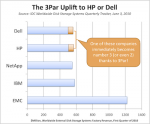After years spent focusing on personal technology, businesses are increasingly turning back to the enterprise. The corporate IT market is much more dynamic and competitive, with a few very large “superpower” companies discovering their power to drive purchasing decisions. If a supplier can create an integrated “stack” of hardware and software, they can push product purchases that might otherwise be overlooked or postponed. This is the main reason that enterprise IT acquisitions work so well: Where a small company must fight to sell their product, a large one can hitch it to a much more strategic sale and have it pulled along.
Hitachi
Everyone Loves 3Par – Here’s Why!
The 3Par acquisition is a slam dunk at under $2 billion. The company has great enterprise-grade SAN technology and a proven ability to sell into high-end accounts but lacked the revenue to go it alone. A major enterprise IT vendor like HP or Dell (not to mention Oracle, IBM, or even NetApp) will kick sales into high gear. But there’s an amazing short-term win to be had for whoever acquires 3Par!
Dell + EqualLogic, Exanet, Ocarina, 3Par = What?
The storage industry got a lot more competitive this morning, as Dell announced plans to buy 3Par. This is the latest round in a well-established race for the enterprise storage dollar, challenging superpower (and Dell partner) EMC in the high-end SAN space. What does this acquisition say about the industry as a whole? Where are we headed?
Lemons Into Lemonade: Seagate Repackages SATA As GoFlex
The external hard disk drive market is incredibly hot right now, but it’s also ultra-competitive. The latest trend is dockable multi-function drives that are friendlier to use and offer advanced features like video playback. Most docks rely on USB 2.0, but Seagate just dropped a bomb on the industry with a simple twist: They moved the intelligence outside the case, repackaging the standard internal SATA connector as GoFlex, an external link to a variety of docks and adapters.
Should Home Users Buy Enterprise Hard Disk Drives?
Are “enterprise” drives worth the extra cost in a RAID enclosure? The reason I ask is I’ve had 2 of 4 Seagate ‘consumer’ (7200.12) drives fail in my (Other World Qx2) enclosure. The two drives that failed were maybe a year old, well short of any ‘MBTF’ expectation. Enterprise drives cost nearly twice that of consumer drives.


